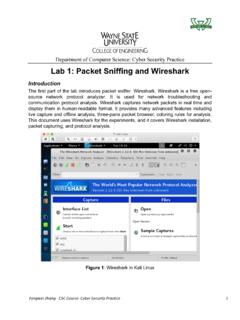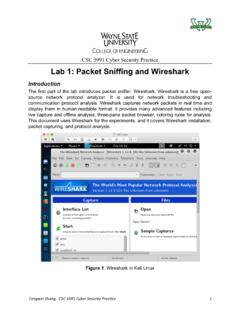Transcription of CMOS COMPARATOR 1. Comparator Design …
1 cmos COMPARATOR 1. COMPARATOR Design Specifications Vo(Vin+ - Vin-)VOHVOL(Vin+ - Vin-)VOHVOLVIHVIL(Vin+ - Vin-)VOHVOLVIHVILVOS(b)(c)(a) Figure 1. COMPARATOR Transfer Characteristics. A COMPARATOR is a circuit that has binary output. Ideally its output shown in Figure 1(a) is defined as follows: 1 < > =++0VV if V0VV if VV-inin OL-ininOHO This is not realizable because its gain is infinity. Figure 1(b) shows a realizable first order transfer characteristic of a COMPARATOR . Its output is defined as follows: <<<>=++++IL-ininOLIH-ininIL-ininVIH-ininOHOV )V-(V if VV)V-(VV if )V-V(A V)V-(V if VV Another nonideal characteristic of practical COMPARATOR is the present of input offset. That is the output does not change until the input difference reached the input offset Vos.
2 Figure 1(c) shows this transfer characteristic. Its output is defined as follows: <<<>=++++IL-ininOLIH-ininILOSV-ininVIH-ininO HOV)V-(V if VV)V-(VV if VA-)V-V(AV)V-(V if VV The input offset can be minimized or ignored by proper layout. If the input step is sufficiently small the output should not slew and the transient response will be a linear response. The settling time is the time needed for the output to reach a final value within a predetermined tolerance, when excited by a small signal. Small-signal settling time is determined by the gain bandwidth product of the amplifier, this will be shown in the opamp circuit section later. If the input step magnitude is sufficiently large, the COMPARATOR will slew by virtue of not having enough current to charge or discharge the compensating and/or load capacitances.
3 The slew rate is determined from the slope of the output waveform during the rise or fall of the output. Slew rate is limited by the current-sourcing/sinking capability in charging the output capacitor. Settling time is important in analog signal processing. It is necessary to wait until the amplifier has settled to within a few tenths of a percent of its final value in order to avoid errors in the accuracy of processing analog signals. A longer settling time implies that the rate of processing analog signals must be reduced. In the following Design , a 10mV signal must be resolved using the COMPARATOR in Figure 2 and 3. The power supply rails are VDD=5V and VSS=-5V. That is, the output will swing by 10V ( from 5V to 5V) when the input signal swing by 10mV( from 5mV to 5mV).
4 The COMPARATOR gain must be at least 10,000 (=10V/10mV). The following specifications will be used in designing the COMPARATOR in Pwell and Nwell processes. VDD=5V, VSS=-5V, AV>10000 , -3<CMR<3, <Vo< , SR=10V/us. 2. Designing the COMPARATOR with NMOS Input Drivers 2 VG1 VGS1 VSSVG2 VGS2 VDDVCVSSVo+-M1w= (1)(2)(7)(3)(6)(5)VSS(4)ISS=5uARb175KM8w = (8)(9) Figure 2. The cmos COMPARATOR Implementation with NMOS input drivers. Figure 2 shows the COMPARATOR schematic diagram implemented with NMOS input drivers. 1. Determine the current drive requirement of M7 to satisfy the SR specification, if pF2CL=20uA12)(10E6)-(2 ESR)(CtVCILLD7=== =dd 2. Determine the size of M6 and M7 to satisfy the output-voltage swing requirement. 46)( )-E40(6)-E20(2)V(KI2W/L)(W/L)( )5( (SAT)NDS777 NDS77DS7DS7(SAT)N0GS7 SSO(min)DS7(SAT)===== = == == Similarly, 3 )( )-(15E6)-E20(2)V(KI2W/L)( ) (5V-VV22SD6(SAT)PSD66O(max)DDSD6(SAT)=== = == 3.
5 Calculate the gain of the second stage. )6)( (6)( )-6)(20E-E15(2)(IW/L)(IK2gggANPSD66SD6 Pds7ds6m6V2=+ =+ = + = 4. Calculate the gain of the first stage to satisfy the overall gain. 100A/10000A10000 AAAV2V1V2V1V= = 5. Determine the first stage biasing current using the minimum allowable size of (W/L)=1, and minimum output offset. (a) Consider M4 and M6. Using the minimum size for M4, determine the current ISD4 that mirror with M6. That is, )20( )(W/L)(ISD664SD4=== (b) Consider M5 and M7. Using the minimum size for M5, determine the current IDS5 that mirror with M7. That is, )20(41IW/L)(W/L)(IDS5DS1DS2SD3DS5SD4DS77 5DS5========= (c) Select the larger of the two ISD4 and adjust the size of M4 ) ( )(II(W/L)6SD6SD44=== 46. Determine the size of M1 to satisfy the gain requirement.
6 -6)( ( )]6)( )(100[(IK2)](IA[W/L)()(IW/L)(IK2gggA2DS1 N2 PNDS1V11 PNDS11DS1 Nds4ds2m1V1=+=+=+=+= Let (W/L)1 be the minimum size of 1. Then re-calculate the gain of the first stage. 14142)100)( ( )6)( (6)(1)-6)( (2)(IW/L)(IK2gggAV2V1 VPNDS11DS1 Nds4ds2m1V1====+=+=+= 7. The minimum size of M5 (=1) in step 5(b) can be adjusted to satisfy the negative input CMR of 3V. )( )-(40E6)-E5(2)V(KI2W/L)(W/L)( )(1)-E40(6)-2( (-5)--3 VW/L)(K2 IVVVVW/L)(K2 IVVV22DS5(SAT)NDS555 NDS5DS5(SAT)T11 NDS1 SSG1(min)DS5(SAT)T11 NDS1DS5(SAT)SSG1(min)===== = =+++= Select the larger of the two, (W/L)5=1. No adjustment needed, since this is the value used earlier in the calculation. 8. The minimum size of M3(=1) in step 5(a) can be adjusted to meet the positive input CMR of 3V.)
7 1211)|-1|3--6)(5-E15(6) (2)V|V|-V-V(KI2(W/L)V|V|-W/L)(K2I-VV22T1 T3G1(max)DDPSD33T1T33 PSD3 DDG1(max)=+=+=+= 5 Select the larger of the two, (W/L)3=1. No further adjustment needed. 9. Determine the size of M8 to provide as the main current mirror for the COMPARATOR . For VDS5= and VDS7= , this voltage corresponds to the value of VG8= or VGS8= Let ISD8=20uA. 41)-6)( (6)-E20(2)V-V(KI2(W/L)22 TNGS8 NDS88=== The external resistor Rb connected between VG8 and ground must be chosen to provide the required current for M8 of 20uA. K1756-E20) (0IV0 RDS8G8b= = = 10. Select the width of each transistor. PAR M1 M2 M3 M4 M5 M6 M7 M8 I(uA) 5 20 20 20 T N N P P N P N N W/L 1 1 1 4 4 W(u)
8 L(u) Leff(u) Finding the W, L to the nearest multiple of = PAR M1 M2 M3 M4 M5 M6 M7 M8 I(uA) 5 20 20 20 T N N P P N P N N W/L 1 1 1 4 4 W(u) * * * * L(u)
9 Leff(u) *Adjusted to satisfy the balance condition to minimize the input offset voltage, Vos: (W/L)W/L)(2(W/L)W/L)(5746 == 6 3. Designing the COMPARATOR with PMOS Input Drivers M8w=60ul= +M5w=30ul= (8)(5)(1)(2)(9)(7)(3) VDD(4) VSS(6)CL2pF+Vo-VSD5 VSD1 VGS3 VGD1VG1 Figure 3. cmos COMPARATOR Implementation with PMOS input drivers. Figure 3 shows the COMPARATOR schematic diagram implemented with PMOS input dricers. 1. Determine the current drive requirement of M7 to satisfy the SR specification, if pF2CL=20uA12)(10E6)-(2 ESR)(CtVCILLD7=== =dd 2.
10 Determine the size of M6 and M7 to satisfy the output-voltage swing requirement. )( )-E15(6)-E20(2)V(KI2W/L)(W/L)( (SAT)PDS777 PSD77SD7SD7(SAT)O(max)DDSD7(SAT)====== == Similarly, 746)( )-(40E6)-E20(2)V(KI2W/L)( )5( (SAT)NDS66 SSO(min)DS6(SAT)==== = = 3. Calculate the gain of the second stage. )6)( (6)(4)-6)(20E-E40(2)(IW/L)(IK2gggAPNDS66 DS6 Nds7ds6m6V2=+ =+ = + = 4. Calculate the gain of the first stage to satisfy the overall gain. 100A/10000A10000 AAAV2V1V2V1V= = 5. Determine the first stage biasing current using the minimum allowable size of 1, and minimum output offset. (a) Consider M4 and M6. Using the minimum size for M4, determine the current ISD4 that mirror with M6. That is, 10uAuA)5(2I2I5uAuA)20(41IW/L)(W/L)(IDS4S D5DS664DS4====== (b) Consider M5 and M7.












